Regulatory signs control traffic; they set limits or give commands and are enforceable by law.
See all Pass the Permit Test Topics
Related Pages
Road Signs | Pavement Markings | Warning Signs | Pass the Permit Test | Permit Practice Tests
To pass the Permit Test you must be able to read and understand Road Signs and Pavement Markings. We have organized the Road Signs into the categories as they appear in the Florida Drivers Handbook.
We recommend you review all the signs and spend a little extra time on those that you don't instantly understand.
Florida Road Signs and Pavement Markings - Guides and Practice Tests
Take The Road Signs Practice Test
Caution zone signs alert you to things like a school crossing, a railroad crossing, a drawbridge, or construction. Understanding caution zone signs is critical for your safety and the safety or people in school cross walks, and construction zones. In addition, as speeding fines are doubled in School Zones and Construction you should follow the posted speed limits.
Regulatory signs are the most common sign you encounter daily. They control traffic; they set limits or give commands and are enforceable by law.
Pavement Markings are lines, symbols, and words that are painted on roadways to help direct drivers and control traffic flow. You must know what the different lines, colors, and symbols mean and obey them.
Warning signs give you advance notice of possible hazards and alert you to drive with caution.
Note: Source of all the signs and definitions below is the 2017 Florida Drivers Handbook
You must bring your vehicle to a complete halt at the stop line. If there is no stop line, stop before entering the crosswalk. If there is no marked crosswalk, stop before entering the intersection at a point near the intersecting roadway where you have a clear view of approaching traffic.
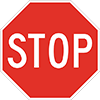
Traffic from all four directions must stop. The first vehicle to reach the intersection should move forward first. If two vehicles reach the intersection at the same time, the driver on the left yields to the driver on the right.
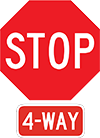
You must slow down and give vehicles crossing your path the right-of-way. If the way is clear, you may move forward slowly without stopping.

On one-way streets and roadways that you are not allowed to enter. You may see this sign if you enter an expressway ramp in the wrong direction. Turn around!
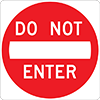
You are going the wrong way on an expressway exit ramp. Do not drive past this sign! Turn around immediately.

You are entering a no passing zone.

You are allowed to pass, but do so with caution.
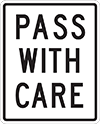
Red circle with red slash. The sign shows what you are not allowed to do.
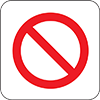
You cannot make a complete turn to go in the opposite direction where this sign is displayed.

You must not make a right turn at this intersection.
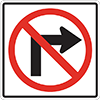
Your speed must not exceed the posted speed in this area.

Posted in active school and work zones. Your fines will be doubled if you are cited for speeding in this area.
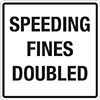
You cannot go straight ahead. You must turn either to the right or left.

You may travel only in the direction of the arrow.
Stay to the right of the divider.
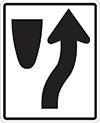
You may not turn right or left during the red light. You must wait for the green signal.
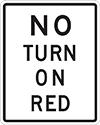
Traffic in left lane must turn left at the intersection ahead (also Right Lane Must Turn).

At the intersection ahead, traffic in left lane must turn left and traffic in adjoining lane may turn left or continue straight ahead.

You must not turn either to the right or to the left at this intersection.
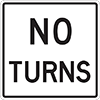
The center lane is shared for left turns in both directions of travel.
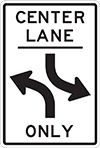
When entering a right turn lane you may encounter bicyclists traveling straight; you must yield to the bicyclists.

This sign lists the maximum recommended safe speed for an exit ramp on an expressway. Slow down to the posted speed.
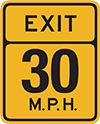
Slower driving traffic must stay in right hand lane unless passing. Slower traffic must move out of left hand lane when being overtaken by a faster vehicle.
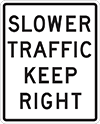
A diamond-shaped marking shows that a lane is reserved for certain purposes or certain vehicles, such as buses or car-pool vehicles during rush hour traffic. Also used in bike lanes.
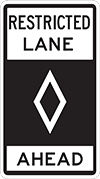
You must only stop for emergencies.

If you stop, you must always park off the pavement of the highway.
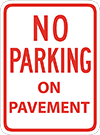
Parking in this space is only for vehicles displaying an official disabled parking permit and transporting a person with a disability.
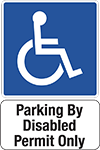
When approaching stopped emergency or service vehicles with flashing lights, you must move over or reduce speed to 20 mph below posted limit.
